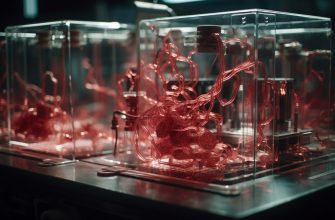Synthetic Muscle – Revolutionizing Robotics and Biomedicine
I’ve always been fascinated by the potential of synthetic muscles. These artificial structures mimic the contraction and relaxation of biological muscles, opening up exciting possibilities in robotics and medicine.
Synthetic muscles represent a significant leap forward in material science and engineering. They combine advanced materials with clever designs to create structures that can change shape or size in response to various stimuli. This ability makes them incredibly versatile and applicable across many fields.
Here’s a quick overview of the main types of synthetic muscles:
- Electroactive polymers
- Shape memory alloys
- Hydrogels
- Carbon nanotube-based materials
Each type has its own unique properties and applications, which I’ll explore in more depth throughout this article.
The impact of synthetic muscles extends far beyond simple mechanical movement. They’re transforming how we approach problems in robotics, prosthetics, and even drug delivery. For instance, soft robots using synthetic muscles can navigate complex environments more easily than traditional rigid robots.
The future of robotics and biomedicine lies in materials that can think and move.
This quote encapsulates the essence of synthetic muscle technology. By creating materials that can respond intelligently to their environment, we’re blurring the lines between artificial and biological systems.
In the following chapters, I’ll explore the composition, mechanisms, fabrication, and applications of synthetic muscles. I’ll also discuss the challenges we face in developing this technology and the exciting future developments on the horizon.
Synthetic muscles stand at the intersection of biology, chemistry, and engineering. They represent a prime example of how interdisciplinary research can lead to groundbreaking innovations. As we continue to refine and improve these artificial muscles, we’re inching closer to creating truly lifelike machines and revolutionizing medical treatments.
Composition of Synthetic Muscles
The composition of synthetic muscles fascinates me. These artificial structures rely on various materials, each with unique properties. Let’s explore the main types:
- Electroactive polymers: These materials change shape when exposed to an electric field. They’re lightweight and flexible, making them ideal for soft robotics.
- Shape memory alloys: These metals remember their original shape and can return to it when heated. They’re strong and durable, perfect for applications requiring high force.
- Hydrogels: These water-based gels expand or contract in response to environmental changes like pH or temperature. Due to their biocompatibility, they excel in biomedical applications.
- Carbon nanotube-based materials: These combine incredible strength with electrical conductivity. They can create muscles that are both powerful and responsive.
The right material choice can make or break a synthetic muscle’s performance.
I find this diversity of materials exciting. It allows engineers to tailor synthetic muscles to specific applications, balancing factors like strength, flexibility, and responsiveness.
Actuation Mechanisms
The way synthetic muscles move fascinates me. Their actuation mechanisms determine how they respond to stimuli. Here are the main types:
- Electric field response: An applied voltage causes the material to deform. This mechanism offers precise control and quick response times.
- Thermal activation: Heat triggers a shape change. While slower than electrical methods, it can produce significant force.
- Chemical stimulation: Changes in the surrounding chemical environment cause the muscle to contract or expand. This method works well in biological settings.
- Light-induced contraction: Specific wavelengths of light trigger movement. This non-contact method allows for remote activation.
Each mechanism has its strengths and weaknesses. For example, electric field responses are fast but may require high voltages. Chemical stimulation works well in the body but can be slow.
Understanding the actuation mechanism is key to harnessing a synthetic muscle’s full potential.
I believe the choice of actuation mechanism significantly impacts a synthetic muscle’s application. It’s crucial to match the mechanism to the intended use.
Fabrication Techniques
Creating synthetic muscles requires sophisticated fabrication techniques. I find the process of turning raw materials into functional muscles intriguing. Here are the main methods:
- 3D printing: This technique allows for complex geometries and customization. It’s particularly useful for creating intricate structures in soft robotics.
- Electrospinning: This process creates ultra-thin fibers, ideal for mimicking natural muscle structure and producing high-surface-area materials.
- Molding and casting: These traditional methods work well for creating larger, uniform structures. They’re often used with shape-memory alloys and certain polymers.
- Self-assembly processes: Some materials can organize themselves into muscle-like structures under the right conditions. This bottom-up approach can create highly ordered structures at the nanoscale.
Each technique has its pros and cons. For instance, 3D printing offers great flexibility but can be slow for large-scale production. Electrospinning produces fine fibers but can be challenging to control precisely.
| Technique | Pros | Cons |
|---|---|---|
| 3D printing | Complex geometries, customization | Slow for large-scale production |
| Electrospinning | Fine fibers, high surface area | Difficult to control precisely |
| Molding and casting | Good for large, uniform structures | Limited complexity |
| Self-assembly | Creates ordered nanostructures | Less direct control over the final structure |
The fabrication method you choose can determine the properties and performance of your synthetic muscle.
I believe mastering these fabrication techniques is crucial for advancing synthetic muscle technology. As we refine these methods, we’ll be able to create more sophisticated and effective artificial muscles.
Performance Metrics
When evaluating synthetic muscles, we need to consider several key performance metrics. These measurements help us compare different types of artificial muscles and assess their suitability for various applications.
- Contraction ratio: This measures how much the muscle can shorten relative to its original length. A higher ratio typically means more powerful movement.
- Response time: This indicates how quickly the muscle reacts to stimuli. Faster response times allow for more precise control.
- Force generation: This metric shows how much force the muscle can exert. It’s crucial for applications requiring strength.
- Cycle life: This measures how many times the muscle can contract and relax before degrading. Longevity is key for practical use.
- Energy efficiency: This tells us how much of the input energy translates into mechanical work.
Here’s a comparison of these metrics across different synthetic muscle types:
| Muscle Type | Contraction Ratio | Response Time | Force Generation | Cycle Life | Energy Efficiency |
|---|---|---|---|---|---|
| Electroactive Polymers | High | Fast | Low | Medium | Medium |
| Shape Memory Alloys | Low | Slow | High | High | Low |
| Hydrogels | Very High | Slow | Low | Low | High |
| Carbon Nanotube-based | Medium | Very Fast | Medium | Very High | High |
The best synthetic muscle isn’t always the strongest or fastest, but the one that best fits the specific application.
Understanding these metrics helps me select the right synthetic muscle for each task. It’s a balancing act between different performance aspects.
Applications in Robotics
Synthetic muscles are revolutionizing robotics. They’re enabling new designs and capabilities that were previously impossible with traditional actuators.
- Soft robots: These flexible machines can navigate complex environments and handle delicate objects. Synthetic muscles provide the gentle, compliant movement needed.
- Prosthetic limbs: Artificial muscles can create more natural, fluid movements in prosthetics. They offer better control and a more lifelike feel.
- Exoskeletons: These wearable robots benefit from the lightweight, powerful nature of synthetic muscles. They can enhance human strength without being bulky.
- Biomimetic actuators: These devices mimic natural biological movements. Synthetic muscles excel at replicating the complex motions of animals and plants.
The future of robotics lies in machines that move and adapt like living creatures.
I’m excited about how synthetic muscles are blurring the line between artificial and biological systems in robotics. They’re paving the way for more versatile, adaptable machines.
Biomedical Uses
I am amazed by the potential of synthetic muscles in medicine. They’re opening up new possibilities for treatment and enhancing existing medical technologies.
- Artificial organs: Synthetic muscles can help create more lifelike artificial organs. For example, they could improve artificial heart designs by mimicking natural heart muscle contractions.
- Drug delivery systems: These muscles can create smart drug delivery devices that release medication in response to specific bodily conditions.
- Tissue engineering scaffolds: Synthetic muscles provide a dynamic environment for growing new tissues. They can apply mechanical stimulation to guide tissue growth.
- Minimally invasive surgical tools: These muscles enable the creation of tiny, flexible surgical instruments that can navigate through the body with minimal damage.
Here’s a quick overview of how synthetic muscles compare to biological muscles in some key areas:
| Aspect | Biological Muscles | Synthetic Muscles |
|---|---|---|
| Control | Neural signals | Various stimuli |
| Energy Source | ATP | Electricity, heat, etc. |
| Self-repair | Yes | Limited |
| Customization | No | Yes |
| Fatigue | Yes | Depends on type |
In medicine, synthetic muscles aren’t replacing natural ones – they’re complementing them, expanding what’s possible in treatment and care.
I believe synthetic muscles’ biomedical applications will significantly impact healthcare in the coming years. They have the potential to improve treatment outcomes and patient quality of life in numerous ways.
Challenges and Limitations
While synthetic muscles offer exciting possibilities, they also face several challenges. As we push the boundaries of this technology, we encounter limitations that require innovative solutions.
- Scalability issues: Many synthetic muscles work well at small scales but struggle when sized up, limiting their use in larger applications.
- Power requirements: Some types require high voltage or significant energy input to function, making them impractical for portable or long-term use.
- Environmental sensitivity: Many synthetic muscles are affected by temperature, humidity, or pH changes. This sensitivity can limit their reliability in varying conditions.
- Biocompatibility concerns: Ensuring that medical applications’ materials are safe for long-term use in the body remains a challenge.
The path to widespread adoption of synthetic muscles is paved with engineering challenges.
I believe overcoming these hurdles will require interdisciplinary collaboration. Materials scientists, engineers, and biologists must work together to address these limitations.
Future Developments
The future of synthetic muscles looks bright. Researchers are working on exciting new capabilities that could revolutionize the field.
- Self-healing capabilities: Imagine muscles that can repair themselves after damage. This would greatly increase their lifespan and reliability.
- Multi-stimuli responsiveness: Future muscles might respond to multiple types of stimuli, allowing for more complex and nuanced control.
- Integration with artificial intelligence: Combining synthetic muscles with AI could create truly adaptive systems that learn and improve over time.
- Biodegradable synthetic muscles: These could be used for temporary medical implants or environmentally friendly robots.
Here’s a speculative timeline for these developments:
| Development | Estimated Timeframe |
|---|---|
| Self-healing capabilities | 5-10 years |
| Multi-stimuli responsiveness | 3-7 years |
| AI integration | 7-15 years |
| Biodegradable muscles | 5-10 years |
The synthetic muscles of tomorrow will blur the line between artificial and living systems.
I’m particularly excited about the potential of AI-integrated synthetic muscles. They could lead to robots and prosthetics that adapt to their users’ needs in real time.
Conclusion
Synthetic muscles represent a leap forward in materials science and engineering. They offer new possibilities in robotics, medicine, and beyond.
Throughout this article, we’ve explored:
- The diverse compositions of synthetic muscles
- Their various actuation mechanisms
- Advanced fabrication techniques
- Key performance metrics
- Exciting applications in robotics and biomedicine
- Current challenges and limitations
- Promising future developments
While synthetic muscles face hurdles, their potential benefits are immense. From more lifelike prosthetics to adaptable soft robots, these artificial muscles are reshaping our technological landscape.
The future belongs to those who can bridge the gap between the artificial and the biological.
I believe synthetic muscles will play a crucial role in the next generation of technologies. As we continue to refine and improve these materials, we’ll unlock new capabilities that were once the realm of science fiction.
The field of synthetic muscles is rapidly evolving. It demands ongoing research, interdisciplinary collaboration, and creative problem-solving. As we overcome current limitations and develop new capabilities, synthetic muscles will undoubtedly transform many aspects of our lives.








